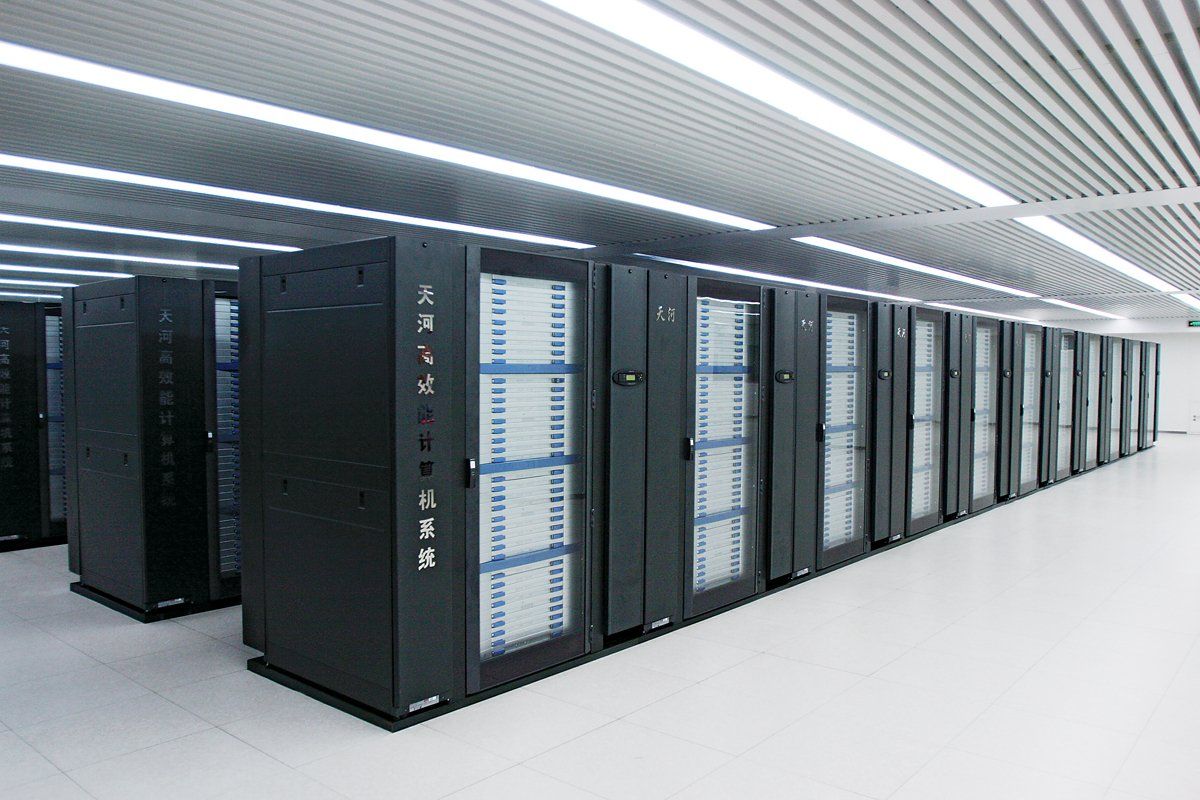
Lawrence Livermore National Laboratory is one of the great symbols of America's scientific and military prowess. For six decades, here on this tranquil campus tucked away in the hill country east of San Francisco, where scientists stroll along leafy paths and zip to meetings on bicycles, huge breakthroughs have been made, like the discovery of a half-dozen elements on the periodic table and the detection of a key component of dark matter.
Livermore's biggest claim to fame involves designing the world's most advanced nuclear warheads—this was the mission of the lab when it was created in 1952 by Edward Teller, father of the hydrogen bomb. To do this, Livermore relies on powerful machines called supercomputers, which hum away inside top-secret, heavily guarded buildings. The U.S. has long dominated the industry. Which is what made the news that Bruce Goodwin, head of the lab's weapons program, received last November all the more momentous: the Chinese had unveiled the world's most powerful supercomputer, a machine five times more powerful than Livermore's biggest computer.
To most of us, this might sound like no big deal, akin to Apple coming out with a faster smartphone than Microsoft. But to the scientists, industry titans, and world leaders who understand how delicate America's position as a global superpower really is, this was a Sputnik moment. Only this time, it wasn't Russia trouncing the U.S. in the space race, but China surging ahead in one of the most vital areas of national security. By running thousands of processors in parallel, supercomputers not only help design weapons systems, they also model climate change, crack codes, and help develop new and life-changing drugs. Cranking out 500 trillion operations per second, just one of Livermore's supercomputers throws off so much heat that if the air-conditioning system were to fail, the computer would start to melt within minutes.
Globally, high-performance computing is a $25.6 billion industry, and whoever holds the lead in the field gains huge economic and military advantages. Or put another way, if the U.S. falls behind in supercomputing it could quickly lose its edge in all areas of science, in industries like oil and gas exploration and pharmaceutical research, and in security and military fields. In the race to develop the most powerful computers, both our economic prosperity and our national security are on the line.
When China flipped the switch on the Tianhe-1A, also called the "Milky Way" supercomputer, last fall, it placed itself at the top of the technology world with a stunning demonstration of its newfound engineering prowess. The Chinese grip on the top spot turned out to be short-lived, since six months later, a team in Japan announced an even bigger supercomputer that bumped Tianhe-1A into second place. Nevertheless, the Chinese had made their point, demonstrating to the world that when it comes to developing the newest, biggest, fastest machines, the inconvenient truth is that China, our No. 1 military and political rival, now runs neck and neck with the U.S. in a field that for decades the U.S. dominated. Experts predict China will soon leapfrog Japan again. Already, it has 74 of the 500 biggest supercomputers in the world, up from zero a decade ago and second only to the U.S., which has 263. And while the U.S. struggles to fund new development, China seems to have limitless resources to pursue its ambitious goals. 'We're scared," says Dona Crawford, who runs computing at Livermore. "This technology is fundamental for our national security, and for our economic competitiveness. Are we really going to let this slip away? Yeah, we're scared."
But they're not bowing out. The Livermore team is now designing an enormous new supercomputer that will yoke together more than a million microprocessors and produce eight times the power of the Tianhe-1A. Built by IBM and code-named Sequoia, it's scheduled to be completed by the end of 2012. The official cost of the project is undisclosed, but it certainly will soar into the hundreds of millions of dollars, with Livermore putting up $200 million and IBM contributing untold millions more. It's a huge and risky bet, even more so in these perilous economic times.
China's emergence as a supercomputing superpower should not have come as a surprise. They've been talking about this for 20 years. ÒIt's just that nobody believed them," says Wu Feng, a professor of computer science at Virginia Tech. "Now it's like a freight train. It's coming on so fast, and a lot of people are worried."
The long road to the Tianhe-1A began in March 1986, when the Chinese announced something called the 863 Project (86/3 is the Chinese rendering of March 1986) to develop advanced technologies. By the early 1990s, the state-funded Dawning Information Industry Ltd. began producing somewhat rudimentary supercomputers that barely made a blip on anyone's radar. But in the new century, China gained momentum. In 2000, it launched a huge supercomputer center in Shanghai. Others soon followed in Beijing, Shenzhen, and Tianjin. A new one in Changsha—a sleek, round, spaceshiplike building—just came online this year.
"Supercomputers are needed everywhere," says Sha Chaoqun, general manager of production at Dawning, which this year will deliver about 1,000 high-performance computing systems to government and corporate customers in China. Most of those machines are not full-blown supercomputers, but they still pack a lot of power. "China's supercomputer centers are now among our biggest customers," says Jim Cashman, CEO of ANSYS, a U.S. company that makes supercomputer-based simulation software used to design everything from GE jet engines to Speedo swimsuits. "Not long ago you wouldn't mention China and supercomputing in the same breath. They've made dramatic strides."
As Dawning builds complete systems, other organizations are developing supercomputer components so that in the future China won't need to rely on American vendors for parts. Next up: hooking together all of its computer centers into a single giant computer brain. "I would almost guarantee that in five years they will have their cyber-infrastructure connected. They could create a distributed supercomputer that is 100 times faster than anything we have in the United States," Virginia Tech's Feng says.
Back at Livermore, the first pieces of Sequoia have started to arrive. On one huge floor stand 10 supercomputers, including an IBM machine called Blue Gene/L, which from 2005 to 2008 was the most powerful supercomputer in the world. Sequoia will produce 40 times as much power, zipping through 20 quadrillion operations per second. (That's 20 petaflops in geek-speak.)
The supercomputer is not one big monolithic device but rather an assemblage of 96 racks, each containing 32 slim little computers, stacked on top of each other like pizza boxes. Hooking these together is the easy part. The real challenge lies in writing software that can run across all these chips. Sequoia will have 1.6 million processors. Nobody has ever written software for a platform like that.
Moreover, before Sequoia has even been assembled, scientists at Livermore are already looking a decade ahead to the next big leap in supercomputers, so-called exascale computers, which will deliver 500 times the power of Sequoia by harnessing together as many as a billion microprocessors. Such a computer will need a completely new kind of processor that sips a lot less power than today's chips—otherwise it would draw more electricity than an entire city. The Chinese are determined to be first to build an exascale computer, and have laid out a road map to get there by 2020.
All told, this may be the biggest, hairiest computer-science problem of all time, "a much bigger agenda of innovation than we've ever seen before," says Dave Turek, vice president of high-performance and exascale computing at IBM. Asked about competing against the Chinese, Turek just laughs. "If you want to know what the Chinese plan is, listen to me speak publicly and a week later that will be the Chinese plan."
In some ways, the U.S. looks like the underdog. Livermore's budget for computing dipped during the past decade, but now has been restored to the level of a decade ago, just north of $200 million a year. Factor in inflation, and in reality Livermore's scientists are trying to do more work with less money. Scientists in China, meanwhile, seem flush. During a tour of Chinese supercomputing centers last summer, Crawford, Livermore's computing director, was dismayed to learn that one center had a budget to hire 40 new scientists this year; her own head count will remain flat. Yet Crawford remains hopeful. She says it was a uniquely American risk-taking attitude that led Livermore and IBM to come up with the radical design for Blue Gene/L, and now "we're hoping we might be able to create that kind of thing again."
Goodwin, the weapons chief at Livermore, puts it more bluntly: "If we don't win this race," he says, "we're screwed. We're in a world of hurt."
Uncommon Knowledge
Newsweek is committed to challenging conventional wisdom and finding connections in the search for common ground.
Newsweek is committed to challenging conventional wisdom and finding connections in the search for common ground.
About the writer
To read how Newsweek uses AI as a newsroom tool, Click here.








